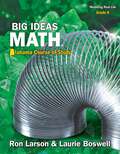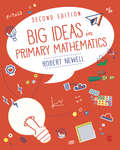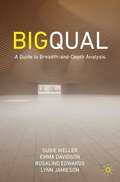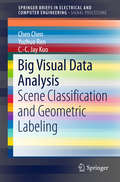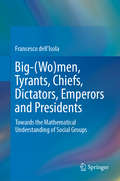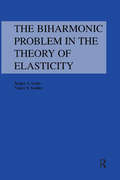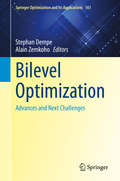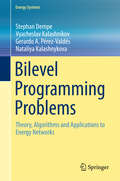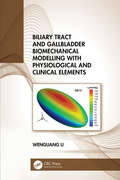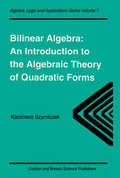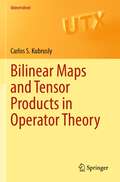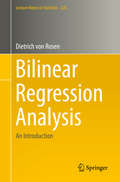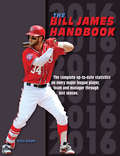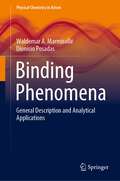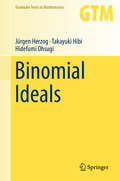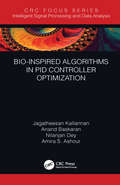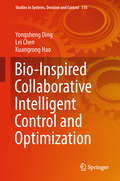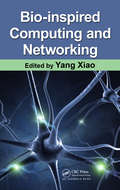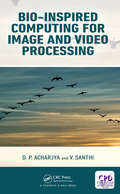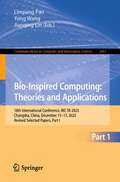- Table View
- List View
Big Ideas Math: Modeling Real Life, Grade K, Volume 1
by Ron Larson Laurie BoswellNIMAC-sourced textbook
Big Ideas Math: Modeling Real Life, Grade K, Volume 2
by Ron Larson Laurie BoswellNIMAC-sourced textbook
Big Ideas Math® Geometry
by Ron Larson Laurie BoswellThis book is a research-based program providing a rigorous, focused, and coherent curriculum for high school students. The pedagogical approach to this program follows the best practices outlined in the most prominent and widely-accepted educational research and standards.
Big Ideas for Growing Mathematicians: Exploring Elementary Math with 20 Ready-to-Go Activities
by Ann KajanderIntroducing sophisticated mathematical ideas like fractals and infinity, these hands-on activity books present concepts to children using interactive and comprehensible methods. With intriguing projects that cover a wide range of math content and skills, these are ideal resources for elementary school mathematics enrichment programs, regular classroom instruction, and home-school programs. Reproducible activity sheets lead students through a process of engaged inquiry with plenty of helpful tips along the way. A list of useful terms specific to each activity encourages teachers and parents to introduce students to the vocabulary of math. This second Big Ideas book covers more advanced concepts, with projects including "One in a Million," where children use grains of rice to model the probability of astronomical odds; "Triangular Tessellations," in which students investigate the geometry and variations created by repeating patterns; and "Fractions of Salaries," where kids use a real-world scenario to multiply and divide fractions.
Big Ideas for Small Mathematicians: Kids Discovering the Beauty of Math with 22 Ready-to-Go Activities
by Ann KajanderIntroducing sophisticated mathematical ideas like fractals and infinity, these hands-on activity books present concepts to children using interactive and comprehensible methods. With intriguing projects that cover a wide range of math content and skills, these are ideal resources for elementary school mathematics enrichment programs, regular classroom instruction, and home-school programs. Reproducible activity sheets lead students through a process of engaged inquiry with plenty of helpful tips along the way. A list of useful terms specific to each activity encourages teachers and parents to introduce students to the vocabulary of math. Projects in this first of the two Big Ideas books include "Straw Structures," where children get hands-on experience with measurement and 3-D visualization; "Kaleidoscopes," in which students use geometry to build a mathematical toy; and "Crawling Around the Möbius Strip," where kids build a physical example of infinity.
Big Ideas in Primary Mathematics
by Robert NewellThis book explains ‘big ideas’ in mathematics in simple terms supported by classroom examples to show how they can be applied in primary schools to enable learning. Carefully linked to the National Curriculum, it covers all the major concepts so you can develop your own mathematical subject knowledge and to give you the confidence to deepen your understanding of the children you teach. This second edition includes: · A new ‘links with mastery’ feature showing how to teach with mastery in mind · A new glossary of key terms · New big ideas and activities throughout
Big Ideas in Primary Mathematics
by Robert NewellThis book explains ‘big ideas’ in mathematics in simple terms supported by classroom examples to show how they can be applied in primary schools to enable learning. Carefully linked to the National Curriculum, it covers all the major concepts so you can develop your own mathematical subject knowledge and to give you the confidence to deepen your understanding of the children you teach. This second edition includes: · A new ‘links with mastery’ feature showing how to teach with mastery in mind · A new glossary of key terms · New big ideas and activities throughout
Big Qual: A Guide to Breadth-and-Depth Analysis
by Rosalind Edwards Lynn Jamieson Susie Weller Emma DavidsonThis upper-level textbook presents a new approach to large scale qualitative analysis – the pioneering breadth-and-depth method. It covers the strengths and deployment of “big qual” as a distinct research methodology. The book will appeal to students and researchers across disciplines and methodological backgrounds.The growing availability of large qualitative data sets presents exciting opportunities. Pooling multiple qualitative data sets enhances the possibility of theoretical generalisability and strengthens claims from qualitative research about understanding how social processes work.Given the evolving possibilities that big data offers the humanities and social sciences, this book will be a must-have resource, building capacity and provoking new ways of thinking about qualitative research and its analysis.
Big Visual Data Analysis: Scene Classification and Geometric Labeling (SpringerBriefs in Electrical and Computer Engineering)
by C.-C. Jay Kuo Chen Chen Yuzhuo RenThis book offers an overview of traditional big visual data analysis approaches and provides state-of-the-art solutions for several scene comprehension problems, indoor/outdoor classification, outdoorscene classification, and outdoor scene layout estimation. It is illustrated with numerous naturaland synthetic color images,and extensive statistical analysis is provided to help readers visualize big visualdata distribution and the associatedproblems. Although therehas been some research on big visual data analysis, little workhas been published on big image data distribution analysis using the modernstatistical approach described in thisbook. By presenting a complete methodology on big visual data analysis withthree illustrative scene comprehensionproblems, it provides ageneric framework that canbe applied to other big visual data analysis tasks.
Big-(Wo)men, Tyrants, Chiefs, Dictators, Emperors and Presidents: Towards the Mathematical Understanding of Social Groups
by Francesco dell'IsolaThis book highlights mathematical ideas to help explain a number of important aspects of the dynamics of social groups. These ideas are similar to those used to describe the behaviour of Lagrangian mechanical systems, and as such this book appeals to anyone wanting to gain an understanding of the intrinsic unity of natural phenomena.
Biharmonic Problem in the Theory of Elasticity
by Sergey A. LurieThis reference work offers a method of deriving exact solutions to the biharmonic equation in the context of elasticity problems, and proposes a number of new solutions. Beginning with an in-depth presentation of a general mathematical model, this text proceeds to outline specific applications, extending the developed method to special harmonic problems of mechanics for conjugated domains. All applications are illustrated with numerical examples.
Bilevel Optimization: Advances and Next Challenges (Springer Optimization and Its Applications #161)
by Stephan Dempe Alain Zemkoho2019 marked the 85th anniversary of Heinrich Freiherr von Stackelberg’s habilitation thesis “Marktform und Gleichgewicht,” which formed the roots of bilevel optimization. Research on the topic has grown tremendously since its introduction in the field of mathematical optimization. Besides the substantial advances that have been made from the perspective of game theory, many sub-fields of bilevel optimization have emerged concerning optimal control, multiobjective optimization, energy and electricity markets, management science, security and many more. Each chapter of this book covers a specific aspect of bilevel optimization that has grown significantly or holds great potential to grow, and was written by top experts in the corresponding area. In other words, unlike other works on the subject, this book consists of surveys of different topics on bilevel optimization. Hence, it can serve as a point of departure for students and researchers beginning their research journey or pursuing related projects. It also provides a unique opportunity for experienced researchers in the field to learn about the progress made so far and directions that warrant further investigation. All chapters have been peer-reviewed by experts on mathematical optimization.
Bilevel Programming Problems: Theory, Algorithms and Applications to Energy Networks (Energy Systems)
by Stephan Dempe Vyacheslav Kalashnikov Gerardo A. Pérez-Valdés Nataliya KalashnykovaThis book describes recent theoretical findings relevant to bilevel programming in general, and in mixed-integer bilevel programming in particular. It describes recent applications in energy problems, such as the stochastic bilevel optimization approaches used in the natural gas industry. New algorithms for solving linear and mixed-integer bilevel programming problems are presented and explained.
Biliary Tract and Gallbladder Biomechanical Modelling with Physiological and Clinical Elements
by Wenguang LiGallstone and other diseases of the biliary tract affect more than around 20% of the adult population. The complications of gallstones, acute pancreatitis and obstructive jaundice, can be lethal. This is the first book to systematically treat biliary tract and gallbladder modelling with physiological and clinical information in a biomechanical context. The book provides readers with detailed biomechanical modelling procedures for the biliary tract and gallbladder based on physiological information, clinical observations and experimental data and with the results properly interpreted in terms of clinical diagnosis and with biomechanical mechanisms for biliary diseases. The text can be used as a reference book for university undergraduates, postgraduates and professional researchers in applied mathematics, biomechanics, biomechanical engineering and biomedical engineering, as well as related surgeons.
Bilinear Algebra: An Introduction to the Algebraic Theory of Quadratic Forms (Algebra, Logic And Applications Ser. #Vol. 7)
by Kazimierz SzymiczekGiving an easily accessible elementary introduction to the algebraic theory of quadratic forms, this book covers both Witt's theory and Pfister's theory of quadratic forms. Leading topics include the geometry of bilinear spaces, classification of bilinear spaces up to isometry depending on the ground field, formally real fields, Pfister forms, the Witt ring of an arbitrary field (characteristic two included), prime ideals of the Witt ring, Brauer group of a field, Hasse and Witt invariants of quadratic forms, and equivalence of fields with respect to quadratic forms. Problem sections are included at the end of each chapter. There are two appendices: the first gives a treatment of Hasse and Witt invariants in the language of Steinberg symbols, and the second contains some more advanced problems in 10 groups, including the u-invariant, reduced and stable Witt rings, and Witt equivalence of fields.
Bilinear Maps and Tensor Products in Operator Theory (Universitext)
by Carlos S. KubruslyThis text covers a first course in bilinear maps and tensor products intending to bring the reader from the beginning of functional analysis to the frontiers of exploration with tensor products. Tensor products, particularly in infinite-dimensional normed spaces, are heavily based on bilinear maps. The author brings these topics together by using bilinear maps as an auxiliary, yet fundamental, tool for accomplishing a consistent, useful, and straightforward theory of tensor products. The author’s usual clear, friendly, and meticulously prepared exposition presents the material in ways that are designed to make grasping concepts easier and simpler. The approach to the subject is uniquely presented from an operator theoretic view. An introductory course in functional analysis is assumed. In order to keep the prerequisites as modest as possible, there are two introductory chapters, one on linear spaces (Chapter 1) and another on normed spaces (Chapter 5), summarizing the background material required for a thorough understanding. The reader who has worked through this text will be well prepared to approach more advanced texts and additional literature on the subject.The book brings the theory of tensor products on Banach spaces to the edges of Grothendieck's theory, and changes the target towards tensor products of bounded linear operators. Both Hilbert-space and Banach-space operator theory are considered and compared from the point of view of tensor products. This is done from the first principles of functional analysis up to current research topics, with complete and detailed proofs. The first four chapters deal with the algebraic theory of linear spaces, providing various representations of the algebraic tensor product defined in an axiomatic way. Chapters 5 and 6 give the necessary background concerning normed spaces and bounded bilinear mappings. Chapter 7 is devoted to the study of reasonable crossnorms on tensor product spaces, discussing in detail the important extreme realizations of injective and projective tensor products. In Chapter 8 uniform crossnorms are introduced in which the tensor products of operators are bounded; special attention is paid to the finitely generated situation. The concluding Chapter 9 is devoted to the study of the Hilbert space setting and the spectral properties of the tensor products of operators. Each chapter ends with a section containing “Additional Propositions" and suggested readings for further studies.
Bilinear Regression Analysis: An Introduction (Lecture Notes In Statistics Ser. #220)
by Dietrich Von RosenThis book expands on the classical statistical multivariate analysis theory by focusing on bilinear regression models, a class of models comprising the classical growth curve model and its extensions. In order to analyze the bilinear regression models in an interpretable way, concepts from linear models are extended and applied to tensor spaces. Further, the book considers decompositions of tensor products into natural subspaces, and addresses maximum likelihood estimation, residual analysis, influential observation analysis and testing hypotheses, where properties of estimators such as moments, asymptotic distributions or approximations of distributions are also studied. Throughout the text, examples and several analyzed data sets illustrate the different approaches, and fresh insights into classical multivariate analysis are provided. This monograph is of interest to researchers and Ph.D. students in mathematical statistics, signal processing and other fields where statistical multivariate analysis is utilized. It can also be used as a text for second graduate-level courses on multivariate analysis.
Bill James Handbook 2015
by Bill JamesThe first, best, most complete annual baseball reference guide available. Full of exclusive stats, this book is the most comprehensive resource on every hit, pitch, and catch in Major League Baseball's 2014 season--and includes player projections for 2015.
Binding Phenomena: General Description and Analytical Applications (Physical Chemistry in Action)
by Waldemar A. Marmisollé Dionisio PosadasThis book presents a unified description of binding equilibrium for a wide variety of systems focusing on acid-base and coordination chemistry, adsorption at interfaces, and electron binding in electrochemistry. It overviews more complex phenomena such as competitive binding to different sites and of different ligands. Multiple sites such as those occurring in macromolecules, colloidal oxides, humid substances, and proteins are briefly discussed and many experimental results for these types of systems are analyzed. Titrations and consideration of the distribution of binding constants are also presented. The book is mainly directed at undergraduate/graduate students of chemistry, biology, and earth sciences. It is supplementary to the standard physical and analytical chemistry courses and will help both students and teachers get a more in-depth knowledge and understanding of the systems analyzed.
Binomial Ideals (Graduate Texts in Mathematics #279)
by Takayuki Hibi Jürgen Herzog Hidefumi OhsugiThis textbook provides an introduction to the combinatorial and statistical aspects of commutative algebra with an emphasis on binomial ideals. In addition to thorough coverage of the basic concepts and theory, it explores current trends, results, and applications of binomial ideals to other areas of mathematics. The book begins with a brief, self-contained overview of the modern theory of Gröbner bases and the necessary algebraic and homological concepts from commutative algebra. Binomials and binomial ideals are then considered in detail, along with a short introduction to convex polytopes. Chapters in the remainder of the text can be read independently and explore specific aspects of the theory of binomial ideals, including edge rings and edge polytopes, join-meet ideals of finite lattices, binomial edge ideals, ideals generated by 2-minors, and binomial ideals arising from statistics. Each chapter concludes with a set of exercises and a list of related topics and results that will complement and offer a better understanding of the material presented.Binomial Ideals is suitable for graduate students in courses on commutative algebra, algebraic combinatorics, and statistics. Additionally, researchers interested in any of these areas but familiar with only the basic facts of commutative algebra will find it to be a valuable resource.
Bio-Inspired Algorithms in PID Controller Optimization (Intelligent Signal Processing and Data Analysis)
by Nilanjan Dey Jagatheesan Kallannan Anand Baskaran Amira AshourThis book discusses in-depth role of optimization to optimize the controller parameters with reference to bio-inspired algorithms. Comparative studies to evaluate the performance of different optimization techniques in terms of the settling time, overshoot and undershoot responses of the frequency deviations, tie-line power flow deviations, and the area control error are included, supported by examples. The book also includes different scenarios of the load frequency controller for single area as well as multi-area thermal power generating unit considering different algorithms. Key Features: Highlights the importance of tuning the power system controller parameters with emphasis on bio-inspiration algorithms Provides some applied applications/examples of the thermal power system Focusses on power system applications based on the optimization algorithms with different single area and multi-area thermal power systems Reports different cases on the interconnected power systems with providing optimal performance by optimizing the controller’s parameters
Bio-Inspired Collaborative Intelligent Control and Optimization (Studies in Systems, Decision and Control #118)
by Lei Chen Yongsheng Ding Kuangrong HaoThis book presents state-of-the-art research advances in the field of biologically inspired cooperative control theories and their applications. It describes various biologically inspired cooperative control and optimization approaches and highlights real-world examples in complex industrial processes. Multidisciplinary in nature and closely integrating theory and practice, the book will be of interest to all university researchers, control engineers and graduate students in intelligent systems and control who wish to learn the core principles, methods, algorithms, and applications.
Bio-Inspired Computing and Networking
by Yang XiaoSeeking new methods to satisfy increasing communication demands, researchers continue to find inspiration from the complex systems found in nature. From ant-inspired allocation to a swarm algorithm derived from honeybees, Bio-Inspired Computing and Networking explains how the study of biological systems can significantly improve computing, networki
Bio-Inspired Computing for Image and Video Processing
by V. Santhi D. P. AcharjyaIn recent years bio-inspired computational theories and tools have developed to assist people in extracting knowledge from high dimensional data. These differ in how they take a more evolutionary approach to learning, as opposed to traditional artificial intelligence (AI) and what could be described as 'creationist' methods. Instead bio-inspired computing takes a bottom-up, de-centralized approach that often involves the method of specifying a set of simple rules, a set of simple organisms which adhere to those rules, and of iteratively applying those rules. Bio-Inspired Computing for Image and Video Processing covers interesting and challenging new theories in image and video processing. It addresses the growing demand for image and video processing in diverse application areas, such as secured biomedical imaging, biometrics, remote sensing, texture understanding, pattern recognition, content-based image retrieval, and more. This book is perfect for students following this topic at both undergraduate and postgraduate level. It will also prove indispensable to researchers who have an interest in image processing using bio-inspired computing.
Bio-Inspired Computing: 18th International Conference, BIC-TA 2023, Changsha, China, December 15–17, 2023, Revised Selected Papers, Part I (Communications in Computer and Information Science #2061)
by Yong Wang Linqiang Pan Jianqing LinThe two-volume set CCIS 2061 and 2062 constitutes the refereed post-conference proceedings of the 18th International Conference on Bio-Inspired Computing: Theories and Applications, BIC-TA 2023, held in Changsha, China, during December 15–17, 2023.The 64 revised full papers presented in these proceedings were carefully reviewed and selected from 168 submissions. The papers are organized in the following topical sections: Volume I: Evolutionary Computation and Swarm Intelligence; and Membrane Computing and DNA ComputingVolume II: Machine Learning and Applications; and Intelligent Control and Application.
